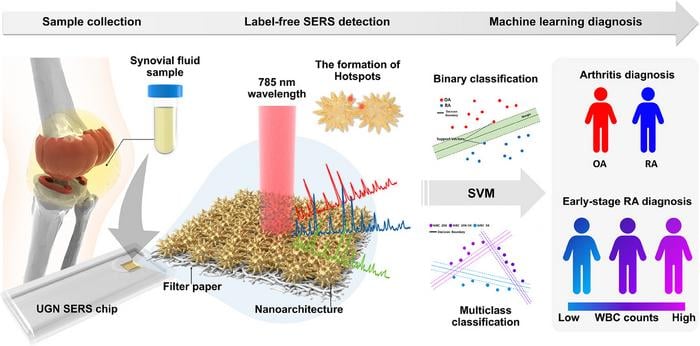Researchers in South Korea have developed a diagnostic platform that can distinguish between osteoarthritis and rheumatoid arthritis in just 10 minutes using a small sample of joint fluid, potentially transforming how these debilitating joint diseases are diagnosed and monitored.
The technology, created by Dr. Ho Sang Jung and his team at the Korea Institute of Materials Science (KIMS) in collaboration with Seoul St. Mary’s Hospital, uses sea urchin-shaped gold nanoparticles on paper to analyze metabolites in synovial fluid, providing rapid results with over 94% accuracy.
“If this technology is commercialized, it will not only aid in diagnosis but also be highly useful in monitoring treatment progress,” said Dr. Jung, who led the research effort. “We also plan to continue expanding our research to cover a wider range of diseases in the future.”
The innovation comes at a crucial time. Studies suggest more than half of people over 65 experience osteoarthritis symptoms, while rheumatoid arthritis affects approximately 1 in 100 people during their lifetime. Though these conditions may present similar symptoms, they require different treatment approaches, making accurate differentiation essential.
Current diagnostic methods rely on X-rays, MRI scans, and blood tests that can be time-consuming, costly, and sometimes limited in accuracy, particularly in early stages of disease when interventions might be most effective.
The research team’s approach focused on analyzing metabolic differences in synovial fluid using Surface-Enhanced Raman Scattering (SERS) technology, which amplifies optical signals from molecules by several million times. This amplification allows detection of trace molecules present in joint fluid that serve as biomarkers for different types of arthritis.
When tested on 120 patients at Seoul St. Mary’s Hospital, the technology demonstrated remarkable precision, not only differentiating between osteoarthritis and rheumatoid arthritis with over 94% accuracy but also determining rheumatoid arthritis severity with more than 95% accuracy.
The platform’s unique design incorporates a highly absorbent paper-based sensor coated with urchin-like gold nanostructures that efficiently capture and analyze the joint fluid samples. Combined with machine learning algorithms, the system can detect subtle differences in metabolite profiles between arthritis types.
The research identified several key metabolites that differentiate the conditions. For example, acetylspermine and adonitol were found at higher levels in osteoarthritis patients, while mannitol and specific glucose compounds appeared more prominently in rheumatoid arthritis samples.
Dr. Jung’s team also demonstrated that their platform could assess the severity of rheumatoid arthritis by correlating metabolite changes with white blood cell counts, potentially allowing physicians to better monitor disease progression and treatment efficacy.
Beyond its diagnostic capabilities, the technology represents a significant advancement in accessibility. Current arthritis diagnosis often involves multiple appointments and tests spanning weeks or months. Reducing this process to minutes could dramatically improve patient care while reducing healthcare costs.
The rapid diagnosis capability may prove particularly valuable for elderly patients, who face higher risks from delayed treatment and may struggle with mobility issues that make repeated medical visits challenging.
Clinical rheumatologists have long sought better tools for early intervention in arthritis cases, as treatment effectiveness typically correlates with how quickly therapy begins. This technology could provide the speed needed to initiate appropriate treatments before significant joint damage occurs.
Another advantage of the platform is its potential for point-of-care implementation. The paper-based sensor design is cost-effective and could theoretically be deployed in various healthcare settings, including smaller clinics without access to expensive imaging equipment.
The research was funded by South Korea’s National Research Foundation and the Ministry of Trade, Industry and Energy. Findings were published online on March 30 and will appear in the April 2025 issue of Small, a respected scientific journal focusing on nanomaterials.
As arthritis prevalence continues to rise alongside aging global populations, innovations like this gold nanoparticle-based diagnostic tool may play crucial roles in addressing the growing healthcare challenge posed by these conditions.
The researchers are now working toward commercialization while simultaneously exploring applications of their technology beyond arthritis diagnosis, potentially extending its use to other inflammatory and degenerative conditions that currently present diagnostic challenges.
If our reporting has informed or inspired you, please consider making a donation. Every contribution, no matter the size, empowers us to continue delivering accurate, engaging, and trustworthy science and medical news. Independent journalism requires time, effort, and resources—your support ensures we can keep uncovering the stories that matter most to you.
Join us in making knowledge accessible and impactful. Thank you for standing with us!

